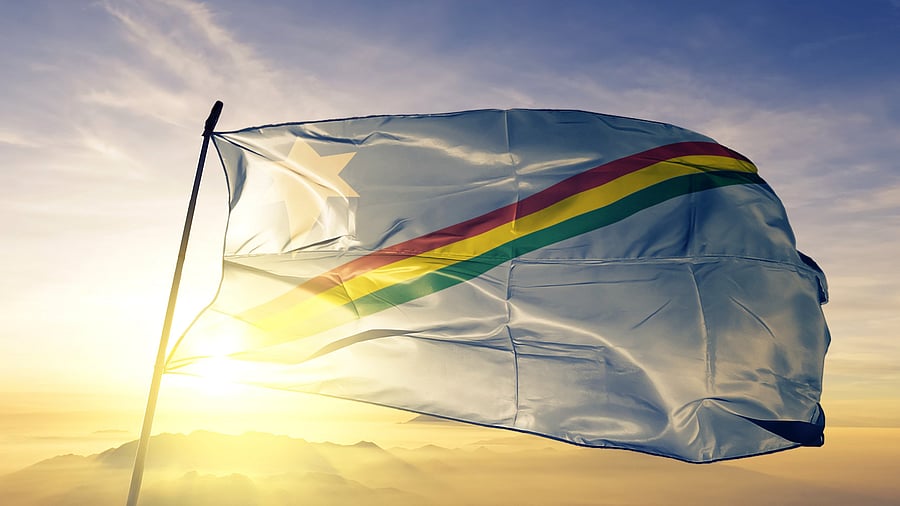
Inage for representation showing Nagaland flag.
Credit: iStock Photo
The Nagas have been waiting for a permanent resolution to the decades-long peace talks going on between the Centre and various Naga groups, including the National Socialist Council of Nagaland (Isak-Muivah) or NSCN(I-M). Despite demands at various times within Nagaland for a political solution, the issue remains unresolved due to differences within the Naga groups.
This difference came to the front again after Ikato Chishi Swu left the NSCN(I-M) and joined the dissident NSCN(I-M) group led by H S Ramsan and Absalom Ramon, based in the jungles of Myanmar, after being disillusioned with the pace of the peace talks. The insurgent group of NSCN(I-M) has been in peace talks with the Centre since 1997, and the dissident group led by Ramsan and Ramon are still up in arms against the Indian government. Ikato Chishi Swu is the son of the late Isak Chishi Swu, one of the founders of the NSCN(I-M). That is what makes this defection important.
Thuingaleng Muivah is a Tangkhul Naga and belongs to Manipur. NSCN(I-M) itself is dominated by Tangkhul Nagas, who primarily are found in the Ukhrul district of Nagaland. On the other hand, the late Isak belonged to the Sumi Naga tribe, mostly inhabiting Nagaland. The presence of Isak as a co-founder of the NSCN(I-M) brought a balance within the insurgent group, making it a group representing the Nagas rather than only a mere Tangkhul Naga group. Now with the exit of Isak’s son quitting the group, NSCN(I-M) has lost a prominent voice from Nagaland. While this exit may not be that significant in terms of cadre strength, as NSCN(I-M) still remains the largest Naga group, this exit once again brings to the fore the tag that often gets associated with the group of being a representative of mainly the Tangkhul Nagas, not a representative of all Nagas.
This setback also comes at a time when the group has already been facing pressure from the Naga society over the delay of a proper resolution on Naga peace talks. The group signed an accord with the Centre in 2015 named Framed Agreement (FA), but the details about the accord still remain in the dark, with both NSCN(I-M) and the Centre maintaining silence. According to reports, even after almost a decade of signing the accord, there has been no solution as the Naga group remains adamant about a separate flag and constitution — demands not agreeable to the Centre, which maintains a clear stand on having a solitary flag and a constitution in the country.
In addition to this, it is the disunity among the Naga groups that has been the main cause of delay. The Naga National Political Groups (NNPGs) — a group of seven insurgent Naga groups — entered into peace talks last decade and signed an accord named Agreed Position (AP) with the Centre in 2017. Unlike the NSCN(I-M), NNPGs are not adamant on a separate flag and constitution and are demanding devolution of power — like the creation of a bicameral legislature with the upper house having representations from every Naga tribe based on selection, legislating on matters under 371A, an article of the Indian constitution granting special provisions to Nagaland to protect customary laws, religious practices and land ownership of the Nagas. Also, NNPGs support a political solution within the Indian constitution.
These differences between the NSCN(I-M) and NNPGs on the nature of the political solution have been the cause of delay, as the Centre has made it clear that there will be one political solution with the Naga groups. Importantly, NNPGs, comprising Naga tribes of Nagaland, have significant support from the influential civil societies of the state, including the Central Nagaland Tribes Council (CNTC), a body representing Ao, Sumi and Lotha Naga tribes, and the Nagaland Gaon Burah Federation (NGBF), a federation of village headmen across Nagaland.
With Ikato Chishi, a Naga from Nagaland, leaving NSCN(I-M), the NNPGs seem to have gained more strength, at least in terms of perception, and this may likely turn out to be a disadvantage to NSCN(I-M), which is already seen as an outsider by a section in Nagaland. The group, already facing criticism from a section of Nagaland for trying to delay the political solution with impractical demands, is likely to face additional pressure from the Centre to agree to a political solution without a separate flag and constitution, with NNPGs already agreeing with the Centre on these issues.
(The writer is a political commentator)